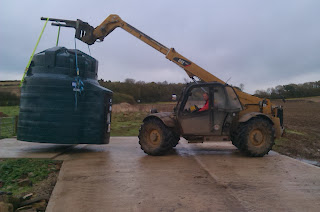The new GWCT website was launched this week, many of the Allerton Project pages have been revitalised, reviewed and revamped. Head of Farming Phil Jarvis thought it an opportune moment to reproduce 'Farming at Allerton'
It is a demanding task to research the interaction between
farming and wildlife. It becomes a bigger challenge when trying to farm
profitably, care for the environment and be an integral part of the local
community.
The Allerton Project has been addressing these issues for
over twenty years whilst meeting a primary objective to produce food to feed a
growing population. The farming system has evolved over two decades and now
embraces many of the modern technologies found in British agriculture.
The farm is 333 hectares of Denchworth and Hanslope clay, growing
winter wheat, winter oilseed rape, winter oats and spring beans. Sheep graze 30
hectares of permanent grassland. The farm has 20 hectares of woodland and
numerous stream and ponds within its boundaries.
In 1992 when the project arrived, the cultivation system
used a plough, disc and power harrow to provide seedbeds for a Suffolk coulter
seed drill. Winter barley, winter beans and spring linseed were a significant part
of the rotation. Research into country stewardship mixes was at the forefront
of our landscape research.
In 1997 the farm moved to a more minimal tillage approach, our
cultivation and drilling equipment was based on discs and tines. The Allerton
Project joined forces with W.J.Wright and Son in 2000 and started a joint
venture farming operation, sharing machinery and labour. The arable farming
area has now grown 800 hectares. In 2001
we introduced a disc cultivator drill which allowed us further reduce our crop
establishment operations. The main
cultivation tractor moved from tyres to tracks to reduce soil compaction.
Tracks replaced tyres to reduce ground pressure at the
Allerton Project
During this period our research looked at a number of issues
affecting soil erosion, organic matter and soil flora and fauna. With the Water
Framework Directive becoming more relevant to British agriculture, our soil and
water demonstrations received increasing interest. In recent years nutrient
management and erosion mitigation measures have become an increasing feature on
the farm. The combined approach of the public, private and charitable sector
stakeholders has enabled practical research and demonstration to thrive, now
Loddington is proud to be a LEAF innovation centre.
The concerns over food safety and security, highlighted in
the government’s ‘Food 2030’ report, mean research into production systems from
‘field to fork’ are receiving increasing scrutiny . The Foresight Report put global food and farming
under the spotlight and the concept of ‘sustainable intensification’ in UK
farming systems is investigated at the Allerton Project. To address some of
these issues, our most recent change in cultivation strategy took place in 2013
with a shift towards direct drilling. Tracks replaced tyres on the combine, a
trash rakes is used to assist weed germination and a purpose built direct drill
is the primary cultivation tool. The challenge of black grass and slugs will be
thoroughly examined in the years to come. As the pressure to produce more food
from a finite land resource increases, new technology will help us improve
efficiency.
The Allerton tractor cab- new
technology will assist us to meter seed, auto-steer, and improve tractor
performance.
The next chapter in our farmland research will also encompass
resource protection, fuel and energy reduction, increasing soil resilience and
lead to a sustainable farming blueprint. The introduction of solar panels, bio
beds, rainwater harvesting, farm plastics recycling and biomass heating are
examples of best practice on view at the project.
With the challenges of volatile commodity markets, weather
related issues and a growing world population the need for a robust food
production system has never been more relevant. Whilst demonstrating a wide
range of land management practices, the Allerton Project is always reliant on a
commercial and profitable farm.
Common Agricultural Policy reforms will also affect the
future British farming; the Allerton Project will be able to help shape and
react to these policy changes with its practical farm demonstrations.











